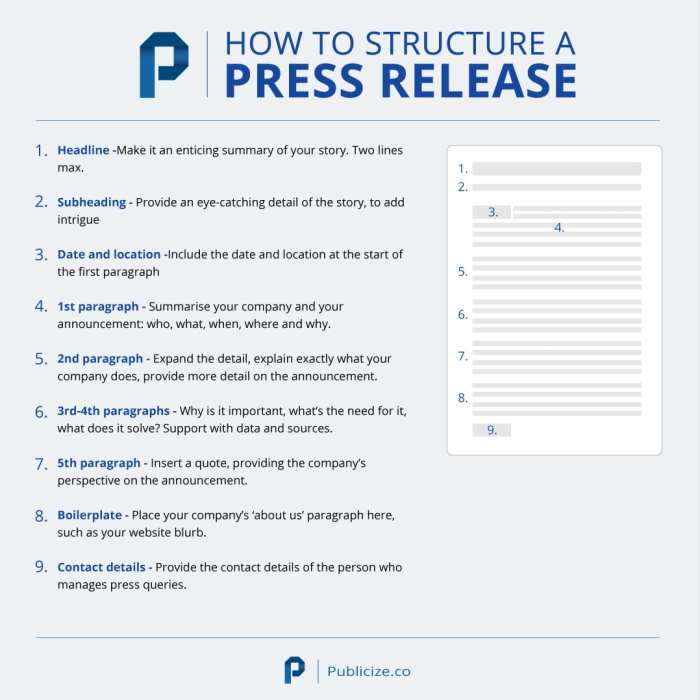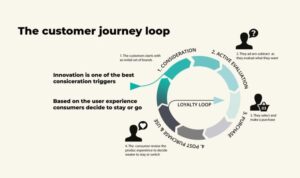Creating a Press Release Strategy sets the stage for this enthralling narrative, offering readers a glimpse into a story that is rich in detail with American high school hip style and brimming with originality from the outset.
Crafting compelling press releases, understanding the importance of distribution channels, and measuring success are just a few steps in this exciting journey towards maximizing your brand’s exposure.
Understanding Press Release Strategy
A press release strategy is a planned approach to distributing information to the media and the public to generate publicity for a company, product, service, or event. It involves crafting a compelling message, identifying target audiences, selecting appropriate distribution channels, and timing the release for maximum impact.
Importance of Having a Press Release Strategy
Having a well-thought-out press release strategy is crucial for businesses to effectively communicate their key messages and reach their target audience. It helps in building brand awareness, increasing visibility, attracting media attention, and ultimately driving traffic and sales.
- It helps in controlling the narrative and ensuring that the right information is disseminated.
- It can boost credibility and establish authority in the industry.
- It can generate buzz and create a positive image for the company or brand.
Examples of Successful Press Release Strategies
Apple’s iPhone launch events are a prime example of a successful press release strategy. By creating anticipation, generating excitement, and controlling the flow of information, Apple is able to build hype and drive sales.
- Tesla’s announcements regarding new product releases and technological advancements also garner widespread media coverage and public interest, showcasing the power of a well-executed press release strategy.
- Coca-Cola’s campaigns promoting sustainability efforts and community initiatives through press releases have helped position the brand as socially responsible and environmentally conscious, resonating with consumers worldwide.
Research and Target Audience
Research plays a crucial role in developing an effective press release strategy. By conducting thorough research, you can gain valuable insights into your industry, competitors, and current trends, allowing you to craft press releases that are timely and relevant.
Importance of Research
- Identify key industry trends and developments
- Understand your competitors and their strategies
- Gain insights into the preferences and interests of your target audience
Defining Target Audiences
When defining your target audience for a press release, it is important to consider factors such as demographics, interests, behaviors, and preferences. By clearly defining your target audience, you can tailor your press releases to resonate with their specific needs and interests.
Tailoring Press Releases
- Use language and tone that resonates with your target audience
- Highlight benefits and features that are most relevant to them
- Include relevant data, statistics, or testimonials that appeal to their interests
Crafting Compelling Press Releases

Crafting a compelling press release is essential to grab the attention of journalists and readers alike. Here are some tips to help you write attention-grabbing headlines for press releases:
Writing Attention-Grabbing Headlines
- Keep it concise and to the point.
- Use strong and impactful words.
- Incorporate numbers or statistics to make it more intriguing.
- Create a sense of urgency or exclusivity.
When it comes to the structure and components of an effective press release, you should follow these guidelines:
Structure and Components of an Effective Press Release
- Headline: Grab attention with a catchy and informative headline.
- Introduction: Provide a brief overview of the news or announcement.
- Body: Include the main details, quotes, and supporting information.
- Boilerplate: Add a short paragraph about your company at the end.
- Contact Information: Include contact details for media inquiries.
To give you an idea of engaging press release content, here are some examples:
Examples of Engaging Press Release Content
“New Study Reveals Surprising Benefits of Daily Exercise”
“XYZ Company Launches Innovative Product to Revolutionize Industry”
“Local Charity Event Raises Over $10,000 for Community Outreach Programs”
Distribution Channels
When it comes to distributing press releases, there are various channels you can utilize to reach your target audience effectively. Each distribution method offers unique benefits, so it’s essential to choose the right channels based on your specific goals and the preferences of your audience.
Email Distribution
- One of the most direct ways to distribute press releases is through email. By sending your release directly to journalists, bloggers, and influencers, you can ensure that your message reaches the right people.
- Benefits of email distribution include the ability to personalize your outreach, track open rates and engagement, and establish direct communication with key contacts in the industry.
- When choosing this distribution channel, make sure to create a targeted list of recipients based on their interests and beat coverage to increase the chances of your press release getting noticed.
PR Websites
- Another popular distribution channel for press releases is PR websites, where you can post your release for journalists and the public to access.
- Benefits of using PR websites include increased visibility, benefits, and the potential for your release to be picked up by other media outlets.
- When selecting PR websites for distribution, consider platforms that cater to your industry or target audience to maximize the impact of your press release.
Social Media Platforms
- Social media platforms like Twitter, LinkedIn, and Facebook can also be effective channels for distributing press releases and reaching a broader audience.
- Benefits of using social media for distribution include the ability to share your release quickly, engage with followers, and encourage social sharing and amplification.
- When deciding on social media channels, choose platforms that are popular among your target audience and align with your brand’s tone and messaging to ensure maximum engagement.
Measuring Success: Creating A Press Release Strategy

In order to determine the effectiveness of a press release strategy, it is crucial to measure success through key metrics that provide valuable insights into brand visibility and engagement. Analyzing the impact of press releases and tracking their performance can help organizations refine their approach and optimize results.
Key Metrics for Measuring Success, Creating a Press Release Strategy
- Media Impressions: The number of times a press release has been viewed by members of the media can indicate the reach and exposure of the brand.
- Engagement Metrics: Monitoring metrics such as click-through rates, social media shares, and comments can help assess the level of audience engagement with the press release.
- Website Traffic: Tracking the increase in website traffic following a press release can demonstrate the impact on driving online visibility and interest.
- Performance: Analyzing the search engine ranking and visibility can show how press releases contribute to improving and online presence.
Analyzing Brand Visibility and Engagement
Understanding the impact of press releases on brand visibility and engagement involves evaluating the reach and resonance of the message with the target audience. By monitoring media coverage, social media mentions, and sentiment analysis, organizations can gauge the effectiveness of their press release strategy in enhancing brand awareness and perception.
Tools and Techniques for Tracking Performance
- Google Analytics: Utilizing Google Analytics can provide valuable insights into website traffic, referral sources, and user behavior following the distribution of a press release.
- Media Monitoring Tools: Leveraging media monitoring tools like Cision or Meltwater can help track media mentions, sentiment, and competitive analysis to assess brand visibility.
- Social Media Analytics: Monitoring social media metrics such as likes, shares, and comments can indicate the level of engagement generated by a press release across various platforms.
- ROI Analysis: Conducting a return on investment analysis to measure the outcomes achieved compared to the resources invested in the press release strategy can help determine the overall success and effectiveness.





